



Analysis of the morphological and environmental changes at the confluence of the Daule and Babahoyo rivers in front of the city of Guayaquil.
Estructura de tallas, relación longitud-masa corporal y factor de condición en tres especies de corvinas (Sciaenidae) en el Océano Pacífico ecuatoriano
ACTA OCEANOGRAFICA DEL PACÍFICO
Instituto Oceanográfico y Antártico de la Armada, Ecuador
ISSN: 1390-129X
ISSN-e: 2806-5522
Periodicity: Semestral
vol. 4, no. 1, 2022
Received: 29 June 2021
Accepted: 09 August 2021
Abstract: The objective of this study was to analyze the size structure, body length-mass ratio and condition factor of Cynoscion albus, Menticirrhus elongatus and Stellifer imiceps in Ecuadorian waters. Data were collected from the commercial catch in Bahía de Caráquez and San Vicente, Manabí. Cynoscion albus was represented by 596 organisms ranging in size from 19.3 to 36.1 cm total length, TL ( = 29.3 cm TL; SD, ± 3.6). A total of 590 individuals were analyzed for M. elongatus, with lengths between 26.7 and 45.9 cm LT ( = 29.3 cm LT; SD ± 3.6). 614 organisms of S. imiceps with a size range of 18.4-36.8 cm LT ( = 28.3 cm LT; SD± 2.7) were analyzed. All 3 species of corvina had hypoallometric growth. The allometry coefficients (.) determined were: C. albus b = 2.91 (CI95% = 2.88-2.94); M. elongatus b = 2.86 (CI95% = 2.80-2.94); S. imiceps b = 2.80 (CI95% = 2.70-2.90). In addition, all 3 species presented a healthy condition as they showed a condition factor higher than unity; C. albus, K = 1.22-1.78 ( = 1.51; ± 0.08); M. elongatus, K = 1.26-2.51 ( = 1.76; ± 0.21), S. imiceps, K = 2.02-4.70 ( = 4.03; ± 0.45). This information will help in the biometric conversions to obtain biomasses based on lengths, as well as in the determination of the health conditions of the fish communities, which will help in their fisheries management.
Keywords: Family Sciaenidae, Cynoscion albus, Menticirrhus elongatus, Stellifer imiceps, body condition.
Resumen: El objetivo de este estudio fue analizar la estructura de tallas, relación longitud-masa corporal y el factor de condición de Cynoscion albus, Menticirrhus elongatus . Stellifer imiceps, en aguas ecuatorianas. Los datos fueron recolectados de la captura comercial realizada en Bahía de Caráquez y San Vicente, Manabí. Cynoscion albus estuvo representada por 596 organismos con tallas entre 19,3 y 36,1 cm de longitud total, LT ( = 29,3 cm LT; DE, ± 3,6). Un total de 590 individuos fue analizado para M. elongatus, con tallas entre 26,7 y 45,9 cm LT ( = 29,3 cm LT; DE ± 3,6). 614 organismos de S. imiceps con un rango de tallas de 18,4-36,8 cm LT ( = 28,3 cm LT; DE± 2,7) fue analizado. Las 3 especies de corvina tuvieron crecimiento hipoalométrico. Los coeficientes de alometría (.) determinados fueron: C. albus b = 2,91 (IC95% = 2,88–2,94); M. elongatus b = 2,86 (IC95% = 2,80–2,94); S. imiceps b = 2,80 (IC95% = 2,70–2,90). Además, las 3 especies presentaron una condición saludable ya que mostraron un factor de condición superior a la unidad; C. albus, K = 1,22-1,78 ( = 1,51; ± 0,08); M. elongatus, K = 1,26-2,51 ( = 1,76; ± 0,21), S. imiceps, K = 2,02-4,70 ( = 4,03; ± 0,45). Esta información ayudará en las conversiones biométricas para la obtención de biomasas basadas en las tallas, así como en la determinación de las condiciones de salud de las comunidades ícticas, lo cual coadyuvará en su manejo pesquero.
Palabras clave: Familia Sciaenidae, Cynoscion albus, Menticirrhus elongatus, Stellifer imiceps, condición corporal.
Introduction
The Family Sciaenidae belongs to the Order Perciformes, comprising 90 genera and 280 species. It is distributed in waters worldwide, mainly in subtropical and tropical waters (Robertson and Allen, 2015; Chao et al., 2015). Among the scyenids is the queen corvinata or yellow croaker, Cynoscion albus, which is distributed in the Eastern Pacific Ocean, from southern Mexico to southern Peru (Fricke et al., 2022). It reaches sizes up to 130 cm total length (TL) (Chao,1995; Robertson and Allen, 2015). It is a commercial species, caught with trawls, gillnets and purse seines (Chao, 1995).
The sweetmouth lambe or mouseMenticirrhus elongatus, is another species of scyenid distributed from northern Mexico to southern Peru (Fricke et al., 2022). It is a pelagic and demersal species (Froese and Pauly, 2022) ranging from near the surface (1 m) to 70 m depth. It inhabits coastal waters, often along sandy beaches and lagoons (Chao, 1995). It feeds on polychaetes, crustaceans and mollusks (Chao, 1995). Its maximum recorded size is 62 cm LT (Valle et al., 2020) and it is caught with trawls, gillnets and seines (Chao, 1995).
The crocodile croaker Stellifer imiceps is distributed in the Eastern Pacific Ocean, from southern Mexico to northern Ecuador (Fricke et al., 2022). It reaches sizes of 25 cm LT and is caught with shrimp trawls and purse seines (Robertson and Allen, 2015) (Chao, 1995).
The fishery production of scyenids, in 2015, was 1 599 244 t for 91 countries, being China, India and Brazil, the countries with the largest catch (De Oliveira and De Oliveira, 2018). In this family, there are cultured species (e.g., Japanese croaker, Larimichthys crocea, coelac corvinon, Sciaenops ocellatus,), with a world production of 121 768 t, in 2009 (Cárdenas, 2012).
On the other hand, it is known that many natural populations of corvina have been heavily depleted by the effects of overfishing and unfavorable environmental conditions (Chao, 1995). Also, according to the International Union for Conservation of Nature (IUCN), C. albus is categorized as data deficient (Chao et al., 2020) while M. elongatus and S. imiceps are of lesser concern (Chao and Espinosa-Pérez, 2020a, b).
Previous works involving issues such as size structure and relationship for species of the Family Sciaenidae, are documented for the Ecuadorian Pacific Ocean (Díaz-Benítez, 2016; Calle-Morán and Galván-Magaña, 2017; Coello et al., 2020, 2022), but there is no information about the condition factor. Therefore, the objectives of this study were: to analyze the size structure, body length-mass ratio and condition factor of Cynoscion albus, Menticirrhus elongatus and Stellifer imiceps, landed in Bahía de Caráquez and San Vicente, Manabí, Ecuador.
Materials and methods
Field phase
Between December 2014 and May 2015, data on Cynoscion albus, Menticirrhus elongatus, and Stellifer imiceps (Figure 1) were collected from commercial catch in Bahía de Caráquez (0°36′00″ S; 80°25′30″ O), Cantón Sucre, and San Vicente (0°35′21″ S; 80°24′32″ W), Province of Manabí, Ecuador. Species identification was performed using the specialized keys of Chao (1995), Jiménez-Prado and Béarez (2004), Robertson and Allen (2015). Fish were recorded in LT in cm, to the nearest mm, by means of an ichthyometer and body mass in g with a digital scale.

Data analysis phase
The size range, mean () and standard deviation (±) were established for each species. Frequency histograms were elaborated for the lengths and body masses observed. In the case of the lengths, their intervals were 5 cm (modified from Holden and Raitt, 1975) and for the body masses it was 100 g.
The length-body mass relationship was estimated using the potential model of Ricker (1975):
MC = a*LT.
where, MC = body mass, LT = total length, . = intersection of the ordinate axis, . = slope of the curve.
Parameter . is also referred to as condition factor or condition coefficient and . as allometry factor or allometry coefficient (Pauly, 1983; Espino-Barr et al., 2008). The model fit to the length-weight data was performed with Minitab v.18 software with their respective 95% confidence intervals (CI95% ).
Once the coefficients of the body length-mass ratio were estimated, the type of growth (isometric or allometric) was determined based on the value of the slope, such that if . = 3, it was isometric type; . > 3, it was hyperallometric and . < 3, hypoallometric (Pauly, 1984; Tesch, 1968; Froese et al., 2011). Also, whether the growth type was isometric or allometric was tested using the isometry test (Pauly, 1983):
 [ecuacion 1]
[ecuacion 1]Where tc = value of the statistic at a significance level of . = 0.05; sd(x) = standard deviation of the log10 values of total length, sd(y) = standard deviation of the log10 values of total weight, r. = coefficient of determination, . - 2 = degrees of freedom.
The allometric condition factor (K) was estimated using the Ricker (1975) model:
 [ecuacion 2]
[ecuacion 2]This index allows to establish the nutritional condition of the fish, so the values should be equal to 1 or close to it, to suggest that the fish have a healthy nutritional condition.
Results
Cynoscion albus presented 596 organisms, with lengths between 19.3 and 36.1 cm LT, ( = 29.3 cm LT; ± 3.6). The class interval with the highest frequency was 25-29 cm TL (n = 264), while the lowest was 15-19 cm TL (n = 1).
In M. elongatus, 567 individuals were recorded, ranging in size from 26.7 to 45.9 cm TL ( = 35.9 cm TL; ± 4.2). The highest number of fish was for the 35-39 cm LT interval (n = 233) and the lowest was for the 45-49 cm LT interval (n = 3).
For S. imiceps a size range was found between 18.4 and 36.8 cm TL ( = 28.2 cm TL; ± 2.6). The interval with the highest number of fish was 25-29 cm TL (n = 365) and the lowest number of fish was 35-39 cm TL with 1 organism (Figure 2).
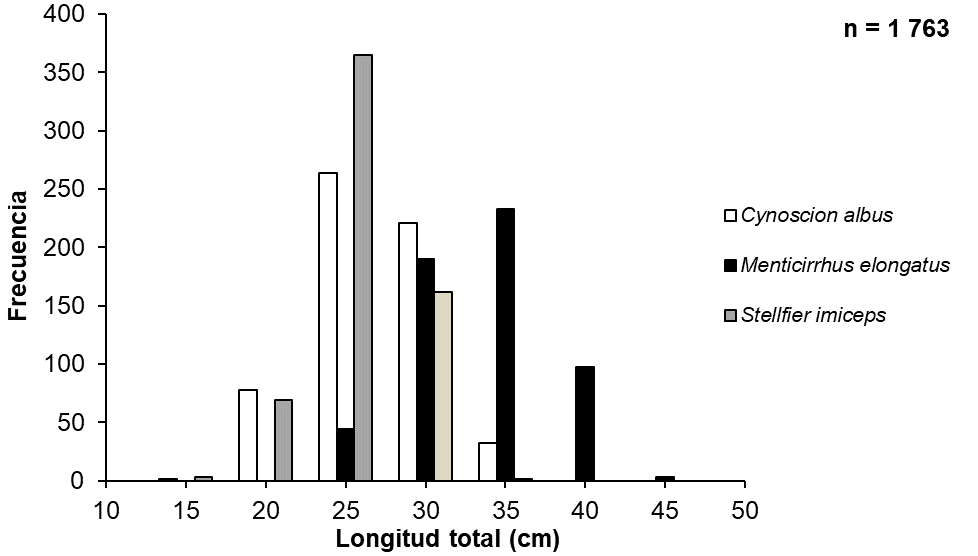
Body masses for C. albus ranged from 89 to 522 g ( = 295.1; ± 102.9). The range with the highest number was 200-299 g (n = 217) and the lowest was 0-99 g with 3 specimens. For M. longatus, a range from 164 to 883 g ( = 502.6; ± 162.1) was observed. The interval with the highest number of fish was for 500-599 g (n = 126) and the lowest was 100-199 g (n = 6). Stellifer imiceps presented a range from 125 to 757 g ( = 476.8; ± 125.3). The range with the highest frequency was also 500-599 g (n = 177) and the lowest was 100-199 g (n = 6) (Figure 3).
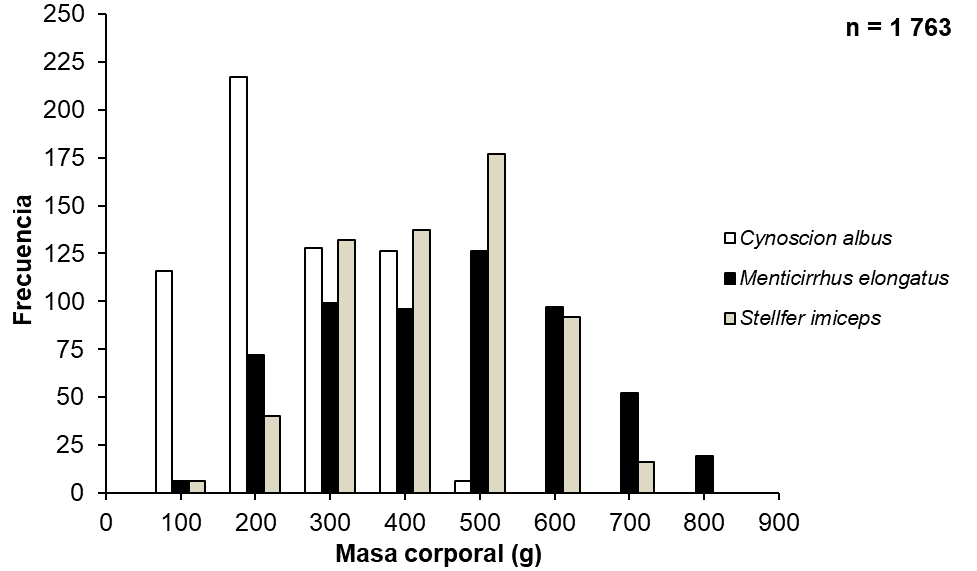
Body length-to-mass ratio
All three species showed hypoallometric growth (. < 3). The allometry coefficients were: C. albus, b = 2.91 (CI95% = 2.88-2.94); M. elongatus, b = 2.88 (CI95% = 2.81 - 2.95); S. imiceps, b = 2.89 (CI95% = 2.82 - 2.97). Results of isometry tests were: C. albus, tc = 5.04 and . < 0.05; M. elongatus, tc = 3.35 and . < 0.05; S. imiceps, tc = 2.80 and . < 0.05. For C. albus, the r. = 0.98 indicated that 98% of the variation in weight data was explained by individual length, while 2% could be attributed to other causes, such as randomness. In the case of M. elongatus, the value was r. = 0.92 showed that 92% of the variation in the data was explained by length and for S. imiceps it was r. = 0.90, i.e. 90% (Fig. 4).
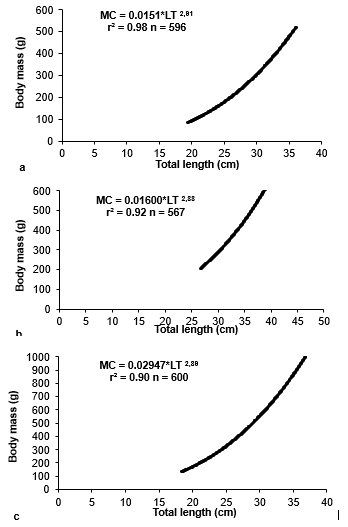
Condition factor
All three species showed a condition factor above unity, meaning that they had a healthy body condition or demonstrated biological well-being. The values were C. albus, K = 1.22-1.78 ( = 1.51; ± 0.08); M. elongatus, K = 1.18-2.12 ( = 1.61; ± 0.17); S. imiceps, K = 1.47-3.56 ( = 2.99; ± 0.25) (Figure 5).
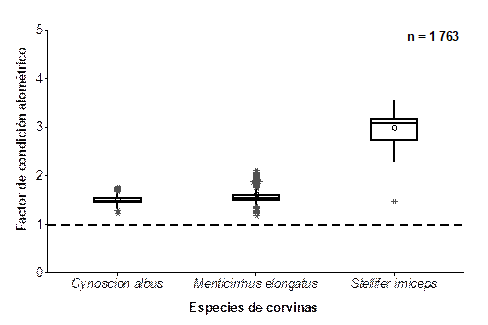
Size structure and body masses
The analyzed sizes of C. albus are within those reported by other authors for Ecuadorian waters (Calle-Morán and Galván-Magaña, 2017) Coello et al., (2020). Larger sizes have been reported in the Gulf of Montijo (Vega et al., 2008) and Parita Bay (Miranda and Sanchez, 2019) in the Panamanian Pacific. Campos (1992) estimated that the size at sexual maturity for C. albus was 65 cm LT, in the Gulf of Nicoya, Costa Rican Pacific, so considering that, the organisms analyzed in this research were immature. Vega et al. (2008) found that 84% of the specimens of C. albus caught were immature. This has also been observed in other species, such as Stolzman's croaker, Cynoscion stolzmanni, in which 75% were immature; Ortiz et al. (2021) found that more than half of the males of the striped croaker, Cynoscion reticulatus, in Sipacate, Pacific Guatemala, were immature.
For M. elongatus, their lengths were within those recorded by Coello et al. , (2020) and, although similar lengths were presented for the species in the central Peruvian Pacific coast, organisms with larger lengths of up to 62 cm TL were also observed (Valle et al. , 2020). Despite being different species, the kettle lambe, Menticirrhus americanus, reaches maximum lengths similar to M. elongatus, with 60 cm LT (Robertson et al. , 2019), so immature organisms could be observed in Santos Bay, Brazilian Atlantic Ocean (Giannini and Paiva-Filho, 1992). Since there are no known works on the size at maturity of M. elongatus, the size of M. americanus, estimated by Clardy et al. , (2014) in the Gulf of Mexico, US Atlantic, at 17.1 cm LT, could be taken as a reference for comparative purposes only, and according to this criterion, all the organisms studied in this research for the Ecuadorian Pacific, were mature.
In the case of Stellifer imiceps, the largest size for the species was recorded since the previous reported size was 25 cm LT according to Robertson and Allen (2015), that is, 11.8 cm larger for the individual found in Ecuadorian waters. In addition, the sizes observed in this work were similar to those of Coello et al. , (2020). Based on the estimated mature size for the species of 30.5 cm LT in the Gulf of Nicoya by Campos et al. , (1984), the organisms in the present work were 79% immature and 21% mature.
With respect to lengths, when comparing the length structure of the different years in the blue croaker, Isopisthus remifer, it was found that they had varied over a period of ten years, observing a decrease from 2004 ( = 25.4 cm LT) to 2014 ( = 22.6 cm LT) by 2.8 cm; as well as in 38% of the landings (Díaz-Benítez et al. , 2016). For the gulf corvina, Cynoscion othonopterus, in the Gulf of California, Mexican Pacific, it was also evident that there was a gradual decrease from 2008 (median, M = 70.3 cm LT) to 2017 (M = 62 cm LT), a difference of 8.3 cm in that decade. The above could be indicative of an increase in fishing intensity, which is reflected in a change in fish length. In this way, the length composition of landings has become more sensitive with respect to fishing; although another interpretation of such changes is that they could be subject to natural variations in recruitment, or when observations cover only a short period of time (Enciso-Enciso et al., 2018).
Regarding body masses, it was observed that the corvina had ranges that varied with those recorded as they were higher for C. albus(6-10 886.2 g), but lower for M. elongatus (2.8-871.4 g) and S. imiceps (1.2-161.9 g) according to Coello et al. , (2020). Body mass values for these species are also different from those observed in other areas of the Eastern Central Pacific, because they were higher for C. albus .ca., 200-1 000 g) according to Vega et al., (2008) and lower for M. americanus (0-400 g) according to Giannini and Paiva-Filho (1992). It is also important to consider that the body mass of the organism can be much greater during the reproductive season than before or after it (Holden and Raitt, 1975), among other factors.
Height-to-body mass ratio
All three species of scyenids had a hypoallometric growth type. Other species of corvina also showed this type of growth, such as the silver croaker, Cynoscion nothus, in the Gulf of Mexico, Mexican Atlantic, with a b = 2.64 (Tapia-García et al., 1988a) and Gulf corvina, Cynoscion othonopterus, with b = 2.78 (Coello et al., 2020). Likewise, scyenids with isometric growth type have been documented such as the corvina aguada, Cysnocion squamipinnis, with b = 3.08 (Coello et al. , 2020) and the lambe mismis, Menticirrhus ophicephalus, with b = 3.04 (Valle et al. , 2020). In addition, of those species of this family with hyperalometric type growth such as C. othonopterus, in the Gulf of California, with b = 3.27 (Acosta-Valenzuela, 2008) and the hollow corvinilla, Stellifer ericymba, with b = 3.60 (Valle et al., 2020) (Figure 6). According to Carlander (1969) and Froese (2006) normal b values range between 2.50 and 3.50; with a slight tendency of b = 3.00 and = 2.99; while, b values < 2.50 and b > 3.50 are not so common.
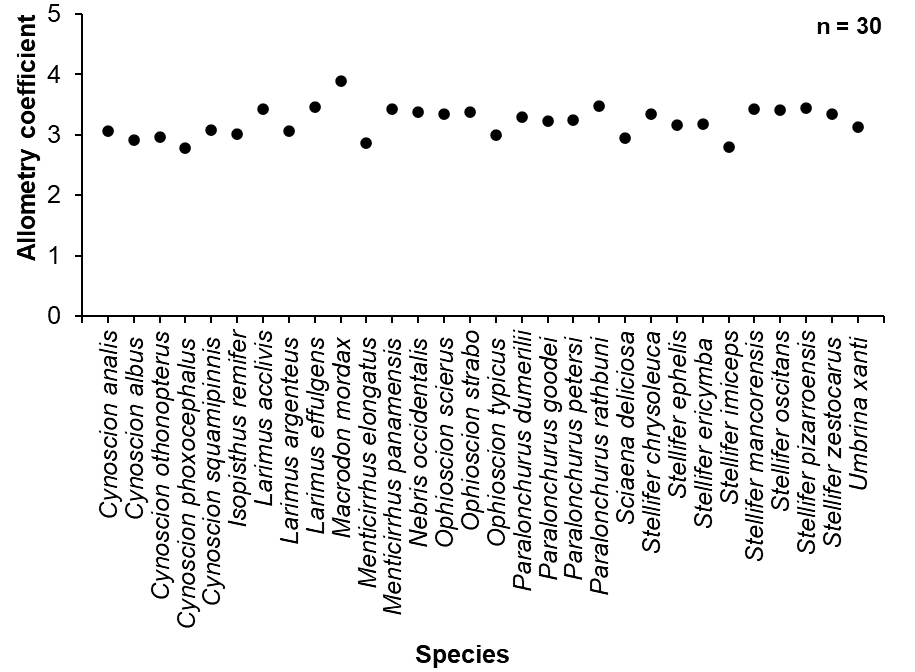
It is important to emphasize that the body length-mass ratio can be different in a species due to sex, sexual maturity, spawning, season of the year, feeding, even during the day; in any case, at any stage the allometry coefficient should be approximately constant and, if there is a change in this index, it is almost certainly during the transition from one stage to another or from one environment to another (Ricker, 1975; Tresierra-Aguilar and Culquichicón-Malpica, 1995). Within the same species, differences can be observed in allometry coefficient by sex, as in the case of Cysnocion reticulatus, where females had a b = 2.35 and males a b = 2.84 (Ortiz et al., 2021). Also, within a species there can be temporal variation, thus, individuals of I. remifer from 2004 had a b = 2.93 and in 2014, it was b = 3.11 (Díaz-Benítez, 2016). In addition to all the above factors, fishing pressure also influences fish growth (Heino et al. , 2015; Audzijonyte and Pecl, 2018; Fidler et al. , 2018; Frank et al. , 2018).
Condition factor
The corvina species presented a healthy condition. These are in agreement with condition factors found for other species such as carota croaker, Johnius carutta, in Visakhapatnam, India, Indian Ocean, with K = 1.29-1.47 (Swamy et al., 2014), but higher than those for C. nothus with K = 1.00-1.02 and sand corvinata, Cynoscion arenarius, with K = 1.00-1.01 (Tapia-García et al. , 1988a; b), as well as for C. othonopterus with K = 0.88-1.02 (Acosta-Valenzuela, 2008) and lorna, Sciaena deliciosa, in Ventanilla, Callao, Peruvian Pacific, with K = 0.96-1.08 (Chero et al., 2014).
There are many factors such as sex, season or time of year, maturity stage, stomach contents, habitat and time that influence the condition factor of a species (Pauly, 1984; Tresierra-Aguilar and Culquichicón-Malpica, 1995). In the case of sex, there are differences and females tend to present a higher body condition due to the reproductive season and higher values than in males, being thus, C. reticulatus with females K = 0.65-1.07 and males K = 0.40-0.72; the corvina verrugato, Micropogonias altipinnis, with females K = 0.23-1.73 and males with K = 0.70-1.10 (Ortiz et al., 2021), as well as in the corvina cachema, Cynoscion phoxpcephalus, in Buenaventura Bay, Valle del Cauca, Colombian Pacific, with females with K = 0.82 and males with K = 0.78 (Rosero-Alpala et al., 2016).
Another factor to consider is the stage of the life cycle, which tends to be higher in juveniles than in adults, as in the case of the white corvineta, Bairdiella chysoura, in Laguna de Términos, Campeche, Mexican Atlantic, and that this condition decreases as they grow and mature (Chavance et al., 1984). This was also observed in C. nothus and C. arenarius, therefore, the body condition of the species varies depending on recruitment, migrations and reproductive activities (Tapia-García et al., 1988a; b).
It should be noted that the condition factor of a fish reflects the physical and biological circumstances and fluctuations in the interaction between feeding conditions, parasitic infections and physiological factors (Le Cren, 1951). This also indicates changes in food reserves and, therefore, is an indicator of the overall condition of the fish (Datta et al., 2013).
The condition factor is suitable for comparing different fish of the same species, it also helps to establish differences related to sex, season or place of capture. It can be used to compare fish of approximately the same length, regardless of their allometry coefficient. In addition, there are occasions when marked differences are observed between populations of the same species, or between the same population in different years, presumably associated with nutritional condition (Ricker, 1975). The condition factor and allometry coefficient show marked seasonal variations that are influenced by the change in ontogenetic development and show their relationship with the biological and ecological factors of recruitment, growth, maturity and spawning (Tapia-García et al., 1988a).
Finally, this research on the size structure, body length-mass ratio and condition factor of C. albus, M. elongatus and S. imiceps in Ecuadorian Pacific Ocean waters will serve as a baseline for stock assessment studies in this Pacific region, since they are resources of local commercial importance and should have a sustainable use. Given the scarce number of works on corvina on these topics, more emphasis should be given so that the growth pattern and body condition of other species in the area can be described and thus know the status of their populations.
Conclusions
The three species of corvina showed a normal distribution with modes in the 25-29 cm TL for Cynoscion albus and Stellifer imiceps and 35-39 cm TL for Menticirrhus elongatus.
The largest size reported for the species S. imiceps was 36.8 cm LT, 11.8 cm larger than the largest previously known size.
All 3 scyenid species had a hypoallometric growth type and showed a healthy nutritional condition.
References
Acosta-Valenzuela, Y. (2008). Aspects of the reproductive biology of the olive ridley croaker (Cynoscion othonopterus) in the Upper Gulf of California (Bachelor's thesis). Instituto Tecnológico del Valle del Yaqui, Sonora, Mexico.
Calle-Morán, M.C. and Galván-Magaña, F. (2017). Diet and food habits of the yellow croaker, Cynoscion albus, in the Ecuadorian Pacific. La Técnica, 17, 72-83.
Chao, L. and Espinosa-Pérez, H. (2020b). Ophioscion imiceps. The IUCN Red List of Threatened Species 2020. International Union for Conservation of Nature. Recuperado de https://dx.doi.org/10.2305/IUCN.UK
Chero, J., Sáenz, G., Iannacone, J. and Aquino, W. (2014). Ecological aspects of parasite helminths of lorna drum, Sciaena deliciosa (Tschudi, 1846) (Perciformes: Sciaenidae) acquired at the fishing terminal of Ventanilla, Callao, Peru. Neotropical Helminthology, 8(1), 59 - 76.
Clardy, S.D., Brown-Peterson, N.J., Peterson, M.S., Leaf, R.T. (2014). Age, growth, and reproduction of southern kingfish (Menticirrhus americanus): a multivariate comparison with life history patterns in other sciaenids. Fishery Bulletin, 112, 178-197.
De Oliveira, C.D.L. and De Oliveira, C.Y.B. (2018). Production Evolution, Catch Estimate and Conservation Status of the Marine Sciaenidae (Pisces, Perciformes). International Journal of Innovative Studies in Aquatic Biology and Fisheries, 4(3), 10-17.
Díaz-Benítez, M.A. (2016). Comparative study of the biological-fishery aspects of corvina (Isopisthus remifer, Order Perciformes, Family Sciaenidae, Jordan and Gilbert, 1882) in the Port of Engabao, Guayas Province (2004 and 2014) (Master's degree case study paper). University of Guayaquil, Guayaquil, Guayas, Ecuador.
Fricke, R., Van der Laan, R. and Eschmeyer W.N. (2022). Eschmeyer's Catalog of Fishes. Retrieved from https://researcharchive.calacademy.org/research/ichthyology/catalog/fishcatmain.asp
Froese, R. and Pauly, D. Editors (2022). FishBase. Retrieved from www.fishbase.org.
Giannini, R. and Paiva-Filho, A.M. (1992). Aspects of the bioecology of Menticirrhusamericanus (Teleostei, Sciaenidae) in Baia de Santos, SP, Brazil. Boletim do Instituto de Pesca, 19(unique), 1-15.
Pauly, D. (1984). Fish population dynamics in tropical waters: A manual for use with programmable calculators. Studies and Reviews 8. Manila, Philippines: International Center for Living Aquatic Resources Management (ICLRM).
Ricker, W.E. (1975). Computation and interpretation of biological statistics of fish populations. Ottawa, Ontario, Canada: Department of Environment, Fisheries and Marine Service.
Robertson, D.R. and Allen, G.R. (2015). Coastal fishes of the Eastern Tropical Pacific: online Information system. Version 2.0. Balboa, Panama, Panama: Smithsonian Tropical Research Institute.
Tesch, F.W. (1968). Age and growth. In: Ricker WE (ed.), Methods for assessment of fish production in freshwaters (pp 93-123). Oxford, England, United Kingdom: Blackwell Scientific Publications.
Tresierra-Aguilar, A.E. and Culquichicón-Malpica, Z.G. (1995). Manual de Biología pesquera. Trujillo, La Libertad, Perú. National Council of Science and Technology (CONCYTEC).
Valle, M., Rosas-Puchuri, U. and Vélez-Zuazo, X. (2020). Improving data deficiencies in length-weight relationships for fish species around an artificial breakwater and adjacent soft-bottom at the central coast of Peru. Journal of Applied Ichthyology, 37(1), 150-157.
Vega, A.J., Robles, Y.A., Boniche, S. and Rodríguez M. (2008). Biological-fishery aspects of the genus Cynoscion (Pisces: Sciaenidae) in the Gulf of Montijo, Panamanian Pacific. Tecnociencia, 10(2), 9-26

